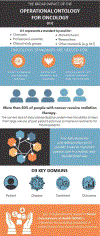Operational Ontology for Oncology (O3): A Professional Society-Based, Multistakeholder, Consensus-Driven Informatics Standard Supporting Clinical and Research Use of Real-World Data From Patients Treated for Cancer
- PMID: 37244628
- PMCID: PMC10741247
- DOI: 10.1016/j.ijrobp.2023.05.033
Operational Ontology for Oncology (O3): A Professional Society-Based, Multistakeholder, Consensus-Driven Informatics Standard Supporting Clinical and Research Use of Real-World Data From Patients Treated for Cancer
Abstract
Purpose: The ongoing lack of data standardization severely undermines the potential for automated learning from the vast amount of information routinely archived in electronic health records (EHRs), radiation oncology information systems, treatment planning systems, and other cancer care and outcomes databases. We sought to create a standardized ontology for clinical data, social determinants of health, and other radiation oncology concepts and interrelationships.
Methods and materials: The American Association of Physicists in Medicine's Big Data Science Committee was initiated in July 2019 to explore common ground from the stakeholders' collective experience of issues that typically compromise the formation of large inter- and intra-institutional databases from EHRs. The Big Data Science Committee adopted an iterative, cyclical approach to engaging stakeholders beyond its membership to optimize the integration of diverse perspectives from the community.
Results: We developed the Operational Ontology for Oncology (O3), which identified 42 key elements, 359 attributes, 144 value sets, and 155 relationships ranked in relative importance of clinical significance, likelihood of availability in EHRs, and the ability to modify routine clinical processes to permit aggregation. Recommendations are provided for best use and development of the O3 to 4 constituencies: device manufacturers, centers of clinical care, researchers, and professional societies.
Conclusions: O3 is designed to extend and interoperate with existing global infrastructure and data science standards. The implementation of these recommendations will lower the barriers for aggregation of information that could be used to create large, representative, findable, accessible, interoperable, and reusable data sets to support the scientific objectives of grant programs. The construction of comprehensive "real-world" data sets and application of advanced analytical techniques, including artificial intelligence, holds the potential to revolutionize patient management and improve outcomes by leveraging increased access to information derived from larger, more representative data sets.
Copyright © 2023 The Authors. Published by Elsevier Inc. All rights reserved.
Conflict of interest statement
[Conflict of Interest Statement for All Authors]
If not already noted, Conflict of Interest: None.
Figures







Comment in
-
Operational Ontology for Oncology: A Framework for Improved Communication and Understanding in Cancer Care.Int J Radiat Oncol Biol Phys. 2023 Nov 1;117(3):551-553. doi: 10.1016/j.ijrobp.2023.02.058. Int J Radiat Oncol Biol Phys. 2023. PMID: 37739606 No abstract available.
References
-
- ASTRO responds to CMS Radiation Oncology Model: Implementation delay and more reforms needed - American Society for Radiation Oncology (ASTRO) - American Society for Radiation Oncology (ASTRO) [Internet]. ASTRO. [cited 2022 Jun 2]. Available from: https://www.astro.org/News-and-Publications/News-and-Media-Center/NewsRe...
-
- Mir R, Kelly SM, Xiao Y, Moore A, Clark CH, Clementel E, et al. Organ at risk delineation for radiation therapy clinical trials: Global Harmonization Group consensus guidelines. Radiotherapy and Oncology. 2020. Sep 1;150:30–9. - PubMed
-
- Caissie A, Brown E, Olson R, Barbera L, Davis CA, Brundage M, et al. Improving patient outcomes and radiotherapy systems: A pan-Canadian approach to patient-reported outcome use. Med Phys. 2018. Oct;45(10):e841–4. - PubMed
MeSH terms
Grants and funding
LinkOut - more resources
Full Text Sources
Medical

